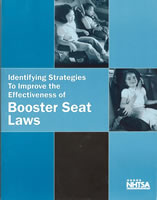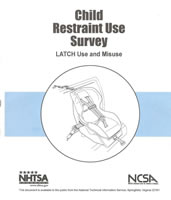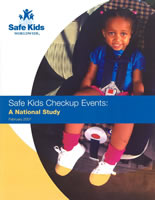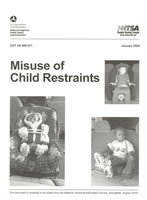Occupant Protection Programs
Improving the protection of vehicle occupants is a proven strategy to mitigate the likelihood and the severity of injuries in the event of a crash. Active and passive restraint systems are used to protect infants, toddlers, young and older children, and adult vehicle occupants. Education and enforcement programs have been implemented at the local, state, and national levels, to maximize the awareness and proper use of these technologies by the driving public.
Describing and evaluating the effectiveness of programs to enhance vehicle occupant protection represents a major area of work at TransAnalytics. Our child passenger safety (CPS) certified staff have trained and coordinated field observation teams to obtain national estimates of the use and misuse of child restraint systems (CRS), and the LATCH (Lower Anchor and Tethers for CHildren) system; and we have developed guidebooks to support observational studies by others. We have evaluated the effectiveness of public information and education programs, car seat inspection stations, and law enforcement strategies to improve the proper use of CRSs, booster seats, and other restraint systems. These evaluations have been conducted across all socioeconomic levels and have included diverse communities.
Identifying Strategies to Improve the Effectiveness of Booster Seat Laws
Lawrence E. Decina, Kathy H. Lococo, Warren Ashburn, William B. Hall, and Janelle Rose
This project explored the possible factors that relate to the use and nonuse of booster seats, and examined the attitudes of law enforcement officers and parents/caregivers concerning booster seat laws. As of June 2007, 38 States and the District of Columbia have included booster seat provisions in their child restraint laws. A recent NHTSA-sponsored observational survey found 41 percent of children ages 4 to 8 restrained in boosters. A literature review uncovered the following reasons that parents/caregivers do not restrain their children in boosters: misunderstanding of the law; underestimation of risk; lack of knowledge about the benefits of booster seats; and permissive parenting style. An observational study conducted in this project found a 9.1 percentage point increase in the use of child safety seats and booster seats for children ages 4 to 8 following enactment of an enhanced child restraint law (booster seat law).
Barriers to the use and enforcement of booster seat laws were addressed in focus groups with parents/caregivers and law enforcement officers. Barriers included parent/caregiver ignorance of child restraint laws and low risk perception; lack of knowledge about the safety benefits of booster seats among the public, as well as among law enforcement officers and members of the courts; low threat of being ticketed for booster seat violations; and lack of commitment to child passenger safety by law enforcement top management.
Educational, enforcement, and legislative strategies were developed to improve the effectiveness of booster seat laws. The educational strategies are teaching parents/caregivers about best practices for restraint use and the risks of inappropriate restraint use; and identification of booster seat resources for low income groups. The enforcement strategies are enlisting support for CPS activities from chiefs of police, training law enforcement officers and judges about CPS best practices and their State laws; high-visibility enforcement of child restraint laws; recording appropriate child restraint law violation data on citations; including law enforcement officers in publicity promoting booster seat laws and best practices; and use of fear appeals in CPS messages to increase parent/caregiver risk perception. Legislative strategies are enactment of booster seat laws in all States; strengthening of booster seat laws to meet best practices; and enactment of primary booster seat laws as well as primary seat belt laws.
This work was performed for the National Highway Traffic Safety Administration; Office of Behavioral Safety Research; 1200 New Jersey Avenue, S.E.; Washington, DC 20590.
To access this report, please visit the following url:
http://nhtsa.gov/staticfiles/DOT/NHTSA/TrafficInjuryControl/Studies&Reports/ AssociatedFiles/810969.pdf
Guidebook to Observe and Assess Use and Misuse of Occupant Restraint Systems
Lawrence E. Decina and Kathy H. Lococo
This project developed a training guide to allow volunteers (who may not have completed the standard CPS training program) to perform observations that yield reliable data regarding non-use and critical misuse of safety belts and child restraint systems.
The project involved a literature review and a telephone survey with leading experts in the field to identify similar research, availability of other guidebooks, and current ongoing training programs used by other entities. Next, an evaluation was performed to determine the extent to which different CRS models and vehicle restraint systems must be explicitly covered in training materials/procedures, to provide observers with the tool to obtain quality use/misuse data on an extensive range of restraint types.
The Guide begins with a brief overview of survey issues for the following target groups: the general public; middle-school and high-school age children; elementary-school age children; infants, toddlers, and pre-school age children, and older adults. Then, the types of sampling techniques that are used in conducting safety belt use and child restraint system studies are discussed. Next, a brief overview of resources needed for data collection is presented, including the number of staff and their qualifications. The Guide then provides a separate chapter for each of the five methods used to collect data. The method used will depend on the target group of interest and the level of detail desired about restraint use and misuse.
This work was performed for the AAA Foundation for Traffic Safety; 607 14th Street, N.W., Suite 201; Washington, D.C. 20005.
To access this report, please visit the following url:
http://www.aaafoundation.org/pdf/restraintguidebook.pdf
Child Restraint Use Survey (LATCH Use and Misuse)
Lawrence E. Decina and Kathy H. Lococo
This study collected quantitative data and other information concerning the restraint use of children in passenger vehicles. In particular, the study obtained information regarding whether drivers with LATCH-equipped vehicles were using LATCH (Lower Anchors and Tethers for Children) to secure their CRSs (child restraint systems) to the vehicle, and if so, were the CRSs properly installed.
Data were collected in 7 States (AZ, FL, MI, MO, NC, PA, WA) in 31 counties at 66 sites. There were 1,182 drivers transporting young children who participated in the survey; and 963 children less than age 5 in child restraint systems (with an internal harness) in the back seats of vehicles with tether anchors were observed. Seventy-six percent of the CRSs observed were tether equipped, and 80 percent were lower-anchor equipped. Tether use for the 600 children less than 5 years of age in a tether-equipped forward-facing CRS in the back seat of a vehicle equipped with tether anchors (somewhere in the vehicle) was 51 percent. Lower anchor use for the 604 children in a lower-attachment-equipped CRS in the back seat of a vehicle equipped with lower anchors (somewhere in the vehicle) was 58 percent. Of all drivers surveyed, 52 percent had heard of a new way to install a CRS without a vehicle safety belt. Of this subgroup who had heard of a new way, 69 percent reported that it was called “LATCH.”
Recommendations are made for educational messages to improve parents’ awareness of the benefits of the use of the tether strap; the convenience and alternative choice of a “better fit” for the lower anchor attachment; and the importance of reading both the vehicle and CRS user’s manuals when installing a CRS.
This work was performed for the National Highway Traffic Safety Administration; Office of Regulatory Analysis and Evaluation; 1200 New Jersey Avenue, S.E.; Washington, DC 20590.
To access this report, please visit the following url:
http://www-nrd.nhtsa.dot.gov/Pubs/810679.PDF
Safe Kids Checkup Events: A National Study
Jacqueline Dukehart, Lorrrie Walker, Kathy H. Lococo, Lawrence E. Decina, and Loren Staplin
This project assessed improvements in knowledge, skills, and abilities among parents who participate in Safe Kids car seat checkup events. Project tasks included development of a database, and entry of survey data for 401 pairs of “matched” forms bearing the same Parent Survey Number for events conducted in Feb 2005 and April 2005. Data were analyzed to determine differences between the two event dates for the groups noted above, in terms of common data elements, and to test for statistical significance wherever practical, to support inferences about the impact (or lack thereof) of this CPS Week activity. Results were conveyed through text summaries supported by graphs and tables.
This work was performed for Safe Kids Worldwide; 1301 Pennsylvania Ave., NW, Suite 1000; Washington, D.C., 20004.
To access this report, please visit the following url:
http://www.usa.safekids.org/content_documents/ACFD37E.pdf
Misuse of Child Restraints
Lawrence E. Decina and Kathy H. Lococo
This study obtained a measure of the current level of misuse of child restraint systems (CRSs) among the general public. The project focused specifically on forms of misuse that can be expected to raise the risk of injury. CRS use and critical misuse data were collected in the Fall of 2002 for 5,527 children weighing less than the driver-estimated weight of 80 lb in 4,126 vehicles in 6 States: Arizona, Florida, Mississippi, Missouri, Pennsylvania, and Washington.
Results showed that 62.3 percent of these children were restrained in a CRS; 25.9 percent were restrained in a safety belt (SB); and 11.8 percent were unrestrained. By weight class, CRS use was 97.1 percent for children less than 20 lb; 86.4 percent for children 20 to 39 lb; 41.7 percent for children 40 to 59 lb; and 10.9 percent for children 60 to 79 lb.
Overall critical CRS misuse was 72.6 percent. Most common critical misuses were loose harness straps securing the child to the CRS and loose vehicle SB attachment around the CRS. Other types of CRS misuses were also observed and recorded in the study. A positive relationship was found between drivers using safety belts and children being restrained—91.7 percent of the children who were transported by belted drivers were restrained in either a child restraint system or a safety belt, compared to 62.3 percent of the children transported by unbelted drivers. Recommendations are provided for periodic monitoring of CRS misuse, research needs, and enforcement and education.
This work was performed for the National Highway Traffic Safety Administration; Office of Research and Technology; 1200 New Jersey Avenue, S.E.; Washington, DC 20590.
To access this report, please visit the following url:
http://www.nhtsa.dot.gov/People/injury/research/Misuse/images/misusescreen.pdf




